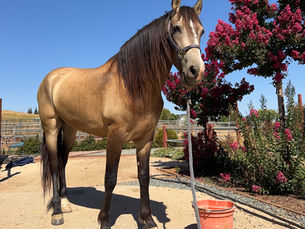Glucosamine for Horses: Benefits, Uses, and What to Know
- Horse Education Online

- Jun 30
- 7 min read
Updated: Sep 11

Glucosamine has become one of the most common joint supplements for horses—but what does it actually do, and is it worth adding to your horse’s routine?
If your horse is showing early signs of joint stiffness, recovering from an injury, or simply aging, glucosamine for horses may help maintain mobility and reduce discomfort. This post covers how glucosamine works, what types are available (sulfate vs. HCl, oral vs. injectable), and what horse owners should know before starting supplementation.
We’ll also explore related search terms like glucosamine chondroitin for horses, glucosamine sulphate for horses, and injectable glucosamine for horses to help you make an informed decision.
What Is Glucosamine and Why Do Horses Need It?

Glucosamine is one of the most widely used joint supplements in the equine world—and for good reason. It’s a naturally occurring compound found in healthy cartilage and joint fluid, where it plays a vital role in maintaining flexibility, cushioning, and shock absorption.
For horses, especially those in regular work or advancing in age, supplementing with glucosamine can help reduce joint wear and support long-term mobility. It’s commonly used in performance horses, including jumpers, barrel racers, and reiners, but is equally popular among owners of retired or arthritic horses who want to improve daily comfort.
You’ll often find glucosamine included in powdered joint supplements, sometimes alongside chondroitin sulfate or MSM, or in injectable glucosamine formulations designed for more immediate absorption. These can be added to grain, given orally in paste form, or administered under veterinary supervision in clinical settings.
There are different types available, including:
Glucosamine sulfate – well-studied and often paired with chondroitin
Glucosamine hydrochloride (HCl) – known for stability in shelf life
Injectable glucosamine – sometimes used for horses in active training or recovery
What’s important to know is that glucosamine isn’t a quick fix or painkiller. It works gradually by supporting the structure of the joints and helping protect cartilage from degenerating. That’s why consistency is key—and why horse owners often start noticing benefits after 3 to 4 weeks of daily use.
If you’re just starting to monitor your horse’s mobility or are curious about whether your horse might benefit from joint support, it may help to also read our guide on how to detect early signs of illness or discomfort.
Proven Benefits of Glucosamine for Horses
Although the research on equine joint supplements is still evolving, many veterinarians and horse owners alike report measurable improvement in stiffness, comfort, and range of motion—especially in horses dealing with regular stress on their joints.
Maintains Healthy Cartilage
Glucosamine helps the body rebuild glycosaminoglycans, compounds essential for cartilage repair. This is especially helpful for older horses or those with early signs of osteoarthritis. By nourishing the joint lining, glucosamine may slow down degeneration, making movement less painful over time.
For example, a 15-year-old dressage gelding in semi-retirement might begin dragging his hind toes more during warmup. Within a few weeks of introducing a glucosamine and chondroitin supplement, many riders report noticing smoother transitions and a reduction in post-ride stiffness.
Reduces Joint Inflammation

While glucosamine isn’t classified as an anti-inflammatory drug, it’s often used in conjunction with chondroitin sulfate and MSM to reduce swelling and increase flexibility. These combinations can help horses who struggle with minor swelling after intense exercise or long trailer hauls.
A good case in point is a competitive barrel horse that often stocks up in the hind legs after weekend races. Adding glucosamine sulfate for horses to her routine might not eliminate swelling entirely, but it can help the soft tissue and joints recover more quickly—especially when combined with proper cool-downs and stretching.
Enhances Comfort in Working and Retired Horses
Horses don’t need to be in competition to benefit. Even trail horses or pasture companions can experience joint stress from years of turnout, hoof imbalance, or previous injuries. Glucosamine supports those everyday wear-and-tear effects and can be part of a proactive wellness plan.
You can also learn more about the importance of monitoring overall health indicators in our post on average heart rate for horses, which includes guidelines for checking baseline vitals that often change as mobility declines.
While the science is still developing, some preliminary research from human and veterinary studies suggests that long-term use of glucosamine may contribute to improved joint health—though results can vary by individual, dose, and formulation. For a deeper dive, PubMed offers a useful summary of joint supplement studies, including those related to glucosamine in horses and dogs.
Are There Risks or Side Effects?
While glucosamine is generally considered safe for horses, especially when given at recommended dosages, it’s important to understand when caution is warranted.
Safe for Most, But Not All
For healthy adult horses, glucosamine rarely causes issues. It’s non-toxic and well tolerated by most equines, even when used long-term. That said, certain conditions may require a more tailored approach.
Horses with known bleeding disorders or those on anticoagulant medications may not be ideal candidates for glucosamine without veterinary guidance. Though rare, there is a potential for glucosamine to interact with blood-thinning agents.
Similarly, horses with a history of gastric ulcers should be monitored, especially if the glucosamine supplement includes NSAIDs or other additives. While glucosamine itself isn’t an ulcer risk, formulations can sometimes contain additional ingredients that might be irritating to the stomach lining.
Beware of Masking Underlying Issues
One common mistake is using joint supplements in place of a proper veterinary diagnosis. If a horse is showing signs of lameness, stiffness, or unwillingness to move, glucosamine might help—but it shouldn’t be the only step. These could be symptoms of deeper issues like navicular disease, joint infection, or soft tissue injury.
To rule out serious conditions early, review our article on how to tell if your horse is sick and speak with your veterinarian before starting any new supplement plan.
Use Only High-Quality Products
The supplement industry isn’t tightly regulated, and quality can vary between brands. Look for products that list glucosamine sulfate or glucosamine hydrochloride with exact dosages and clear labeling. Avoid supplements that rely solely on vague “proprietary blends” without transparency.
When possible, choose formulations that have been independently tested or recommended by veterinarians. Products that also include chondroitin sulfate or hyaluronic acid may offer more comprehensive support, but these additions should be appropriate for your horse’s needs and workload.
Conclusion
Glucosamine has earned its place in many equine supplement regimens for good reason. With a strong safety profile, accessible forms like powders and pellets, and the potential to ease joint discomfort, it’s an appealing option for owners of aging horses, sport horses, and those recovering from injury.
However, glucosamine isn’t a miracle fix. It works best as part of a comprehensive care plan that includes proper nutrition, regular exercise, hoof care, and veterinary monitoring. If you’re unsure whether glucosamine is right for your horse, start by reading our guide on how to tell if your horse is sick to understand what else might be going on.
Finally, always check for product quality, discuss options with your vet, and track how your horse responds over time. Joint support is a long game—and glucosamine is just one part of it.
If your horse is picky with powders, a small serving of soaked alfalfa pellets makes an effective carrier for joint supplements like glucosamine. It improves palatability and helps you deliver an accurate dose without a large grain meal. For a sensible amount to use as a carrier (by bodyweight and goal), start with the Alfalfa Pellet Feeding Planner and adjust to the smallest quantity that reliably delivers the supplement.
FAQ
What age should you start giving glucosamine to horses?
There’s no universal rule, but many owners begin supplementing with glucosamine around the age of 10 to 12, especially in disciplines like dressage, eventing, or reining where joint stress accumulates over time. For performance horses that start training early, some vets recommend beginning even sooner—as young as 6 or 7—if there are signs of wear or a family history of joint issues. Early supplementation may help slow cartilage degradation and support long-term joint resilience, especially when combined with regular hoof care and conditioning.
Can glucosamine replace joint injections?
No, glucosamine should be viewed as preventive maintenance, not a replacement for therapeutic treatments like joint injections. Intra-articular injections deliver powerful anti-inflammatory relief directly into the joint and are typically used for horses with diagnosed arthritis or significant lameness. Glucosamine can be helpful between injection cycles or as part of a long-term plan, but it doesn’t deliver immediate or targeted results like hyaluronic acid or corticosteroid injections. If your horse requires injections, speak with your vet before discontinuing them in favor of supplements.
Do all horses need glucosamine?
Not every horse needs a joint supplement. Young horses in light work with no joint stress or history of lameness may not benefit much. Glucosamine is most valuable for horses that:
Are in regular or intense training
Have a previous joint injury
Are middle-aged or older
Show mild signs of stiffness or reluctance to move
It’s also popular in disciplines with repetitive strain like barrel racing, jumping, or endurance riding. Horses with upright pasterns, poor hoof conformation, or previous joint issues are especially good candidates.
Are there signs that glucosamine isn’t working?
If your horse doesn’t show noticeable improvement in stiffness, movement, or recovery after 6 to 8 weeks of consistent use, the supplement may not be effective—or may not address the true cause of discomfort. Signs that it’s not working include:
Continued or worsening stiffness
Increased post-exercise swelling
No change in range of motion
Behavioral issues under saddle that don’t improve
At this point, a veterinary exam is important to rule out more serious conditions like osteochondrosis, soft tissue injury, or ligament damage. Keep in mind that supplements work best in mild or early-stage cases, and may offer little benefit for advanced degenerative issues.
Is there a risk of overdose with glucosamine?
Glucosamine is generally safe, and toxicity is rare. That said, extremely high doses—often from stacking multiple joint supplements—can lead to digestive upset, including diarrhea or colic-like symptoms in sensitive horses. It’s best to avoid giving multiple products with overlapping ingredients unless your vet has advised it. Most horses do well with 5,000 to 10,000 mg per day, depending on weight and condition. Always read labels and adjust dosage based on activity level, age, and overall joint health.
What other ingredients pair well with glucosamine?
For more complete joint support, glucosamine is often paired with:
Chondroitin sulfate – reduces cartilage breakdown
MSM (Methylsulfonylmethane) – a natural anti-inflammatory
Hyaluronic acid – helps maintain joint lubrication
Boswellia serrata – an herbal anti-inflammatory with growing popularity
Devil’s claw or yucca – sometimes included for pain relief, though they may not be competition-safe
These combinations work synergistically to target inflammation, fluid balance, and cartilage strength. Choosing a product that combines 2 to 3 of these compounds can offer broader benefits than glucosamine alone—especially for horses under heavy stress.










Comments